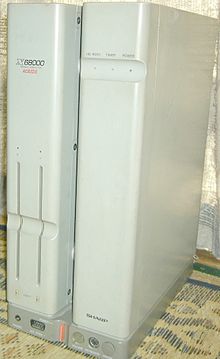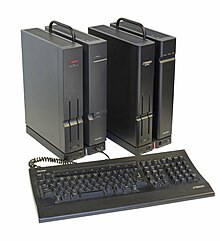
Back شارب إكس68000 Arabic شارپ اكس68000 ARZ Sharp X68000 Czech X68000 German Sharp X68000 Spanish X68000 Finnish Sharp X68000 French X68000 ID Sharp X68000 Italian X68000 Japanese
This article includes a list of general references, but it lacks sufficient corresponding inline citations. (September 2011) |
 X68000ACE-HD | |
| Developer | Sharp Corporation |
|---|---|
| Manufacturer | Sharp Corporation |
| Type | Home computer[1] |
| Release date | 1987[1] |
| Lifespan | 1987-1996 |
| Discontinued | 1996 |
| Media | Floppy disk |
| Operating system | Human68k, NetBSD, OS-9 |
| CPU | Motorola 68000 family |
| Memory | 1 to 12 MB of RAM |
| Display | 14" CRT 256×256 to 1024×1024 pixels 16 bits |
| Graphics | VINAS 1 + 2, VSOP, CYNTHIA / Jr, RESERVE |
| Sound | Yamaha YM2151 OKI MSM6258 |
| Controller input | D-pad, Keyboard, Mouse |
| Power | 100V AC 50/60 Hz |
| Predecessor | X1 |





The X68000 (Japanese: エックス ろくまんはっせん, Hepburn: Ekkusu Rokuman Hassen) is a home computer created by Sharp Corporation. It was first released in 1987 and sold only in Japan.
The initial model has a 10 MHz Motorola 68000 CPU, 1 MB of RAM, and lacks a hard drive. The final model was released in 1993 with a 25 MHz Motorola 68030 CPU, 4 MB of RAM, and optional 80 MB SCSI hard drive. RAM in these systems is expandable to 12 MB, though most games and applications do not require more than 2 MB.
The X68000 has graphics hardware similar to arcade video games of the late-1980s, with custom coprocessors supporting scrolling, tiled backgrounds, and large numbers of sprites. Sound is supplied through multiple sound chips supporting 8 channels of FM synthesis and one channel of adaptive differential pulse-code modulation audio, which are mixed down to 2 analog stereo channels via a DAC chip. As such, video gaming was a major use of the X68000.
- ^ a b Szczepaniak, John; McFerran, Damien (4 January 2023). "Best Sharp X68000 Games: 20 Titles We Want On The X68000 Z Mini". Time Extension. Hookshot Media. Retrieved 29 July 2024.

